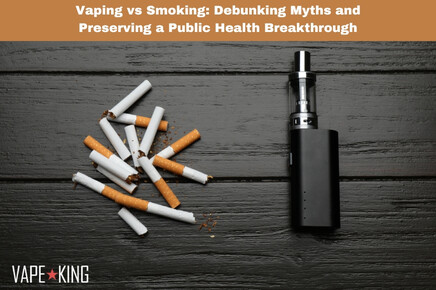Free Shipping on orders R1000 or more!
Why Vaping Matters: Separating Facts from Myths to Save Lives

In the Moral Panic Over Vaping, We Risk Forgetting That Cigarettes Kill
Adapted from an article by Martha Gill, originally published in The Guardian on 10 November 2024.
In recent years, vaping has become a controversial topic, sparking debates that risk overshadowing its primary benefit: reducing smoking-related deaths. As Martha Gill points out in her article, “In the moral panic over vaping, we risk forgetting that cigarettes kill,” public discourse is increasingly focused on the potential risks of vaping while neglecting the monumental harm caused by smoking.
A Public Health Breakthrough
Vaping is arguably one of the most effective tools for quitting smoking. With a quit success rate of 60% to 74%, it has helped millions transition away from cigarettes. According to Action on Smoking and Health, over half of people who quit smoking in the last five years used vapes to do so—a total of 2.7 million individuals. Yet, policies aimed at restricting vaping, such as flavor bans, increased taxes, and outlawing disposable vapes, threaten to undermine this progress.
Smoking remains a leading cause of preventable death in the UK, killing 76,000 people annually and costing the NHS £2.5 billion each year. In contrast, vaping has managed to achieve what decades of government initiatives could not: a significant reduction in smoking rates.
Understanding Vaping Risks
Vaping is not without risks, but they pale in comparison to those posed by cigarettes. Studies show that the cancer risk from e-cigarette emissions is less than 1% of that from tobacco smoke. While vaping liquids may contain trace amounts of harmful chemicals like formaldehyde and nitrosamines, these levels are negligible compared to the toxic cocktail found in cigarette smoke, which includes arsenic, carbon monoxide, and around 70 carcinogens.
Despite this, misinformation persists. Over half of smokers in England now mistakenly believe that vaping is as harmful, or more harmful, than smoking. This misperception could deter smokers from switching to a safer alternative.
Addressing Youth Vaping Without Harming Adults
Concerns about underage vaping are valid. Nicotine exposure can negatively impact developing brains, and about 9% of 11- to 15-year-olds in the UK reportedly vaped frequently in 2023. However, draconian measures like flavor bans and excessive taxes risk driving adult smokers away from vaping, potentially pushing them back to cigarettes.
The solution lies in better enforcement of existing age restrictions and educating parents and schools to address the issue, rather than introducing policies that penalize adult users.
A Lesson from Australia
Gill cites Australia’s experience as a cautionary tale. In 2021, the country made vapes prescription-only, resulting in a low uptake of vaping and a rise in smoking rates. This demonstrates the fragile nature of progress in reducing smoking-related deaths.
Moving Forward
As Gill aptly warns, the moral panic surrounding vaping threatens to undo years of public health gains. While it’s important to regulate vaping to protect young people, these efforts must not come at the expense of adult smokers seeking a safer alternative. By balancing regulation with education, we can ensure that vaping continues to serve as a critical tool in the fight against smoking.
This blog post was inspired by Martha Gill’s article, which originally appeared in The Guardian. For more insights, read the full piece here.
No posts found
Write a review

